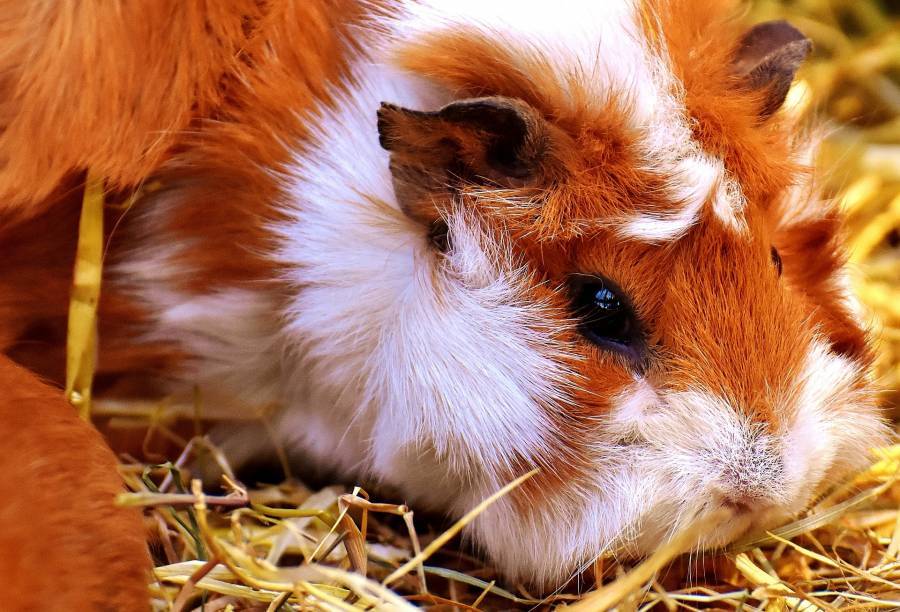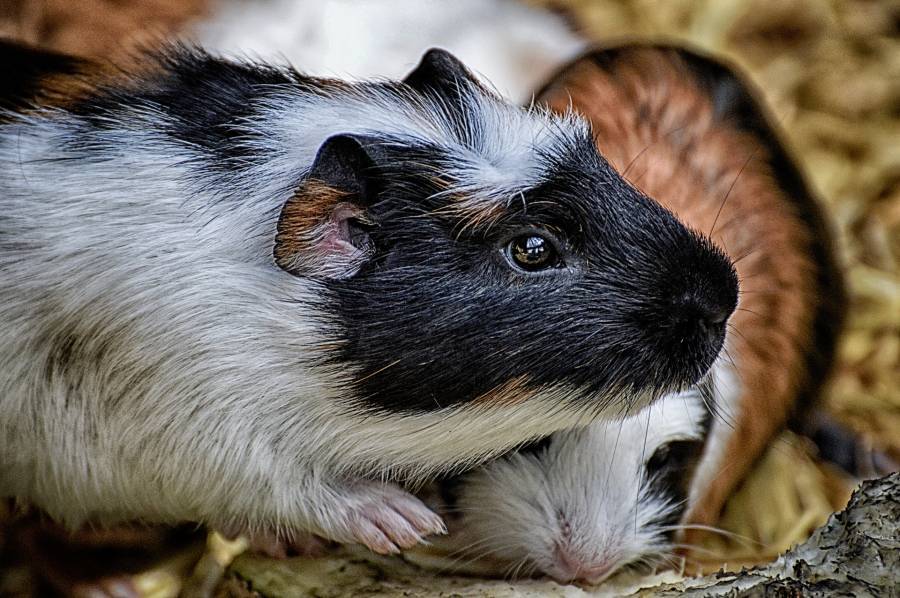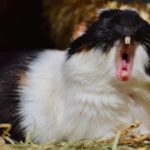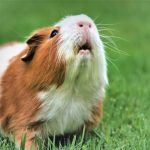Quick Navigation
Are you worried about finding a bald spot on your guinea pig?
Guinea pigs make great pets and are easy to care for.
One may only consider guinea pigs high maintenance when considering how much time you spend with them.
It also takes longer to clean up after them as their hygiene is of the utmost importance.

If you notice bald spots in your time with your guinea pig, this blog post is for you.
What are these bald spots?
Bald spots are hairless areas and are rather common in albino guinea pigs.
It can be alarming if you do not know why as a pet owner.
Here are some causes of bald spots in guinea pigs explained:
1. Barbering
Balding spots in guinea pigs do not occur due to aging; in most cases, it is due to a fungal or parasite infection.
However, before subjecting your guinea pig to any treatment, you must be sure about the cause.
If you notice bald spots on your guinea pig, you should rule out the harmless causes.
Then you should monitor for the signs and symptoms to find out if it is something worse, like an infection.
Barbering is the pulling out of guinea pigs’ hair, typically done by other guinea pigs or themselves.
It can result in bald patches where hair has been pulled out.
The causes are usually boredom (when it is self-inflicted) or maybe a behavioral problem if your guinea pig does it to others.
The cause and environment have to be taken into account when tackling barbering.
A good way to go about it is the addition of some good-quality hay.
Furthermore, keeping an eye on their everyday habits is also an excellent way to nip the problem in the bud.
2. Pregnancy
Another reason why your guinea pig has bald spots is pregnancy.
The pregnancy may be the reason behind bald patches if you have a sow or a pregnant female guinea pig.
During pregnancy, especially during the later stages, sows can experience hair thinning or even hair loss.
It is due to lactation since hormones affect the growth of hair.
It is completely normal, and if your guinea pig is experiencing bald spots during pregnancy, you need not worry.
However, you will want to consult a vet if it persists after pregnancy.
3. Functional Cystic Ovaries
A functional cystic ovary is a sac that can form on a sow’s ovary during or after ovulation.
It causes swelling of the abdomen and incredible pain and hair loss along both sides of the body.
These cysts are not usually cancerous; treatment can be done simply by removing the affected ovaries.
So, this can be a contributing factor to why your guinea pig may have a bald spot.
4. Fungal Infections
One reason your guinea pig may be experiencing bald spots, particularly on the head or behind the ears, could be fungal infections.
Fungal infections appear as ringworms and majorly affect the face, so you may notice bald spots on the head.
Other symptoms of fungal infections include itchiness and dry skin.
If the bald spots are behind the ears, it is not necessarily a fungal infection.
It is normal for guinea pigs to experience hair loss behind the ears.
So it should only be a cause of concern if the skin behind the ears appears red and inflamed.
It may be accompanied by crusty scabs or soreness in any other way.
If your guinea pig has a fungal infection, it is best to practice hygiene.
Furthermore, you should keep a reasonable distance from other animals and humans since infections can spread by contact.
As for treatment, you can go for antifungal creams, medicated shampoos specifically for this purpose, and for severe cases, oral antifungal medicines.

Microsporum Fungal Disease In Guinea Pigs
Microsporum Fungal disease is a form of infection in guinea pigs caused by a species of fungus known as the Trichophyton mentagrophytes fungus.
It is characterized particularly by bald patches that start at the head.
They appear first around the eyes, nose, and ears and may even spread to the back.
Treatment for this involves oral antifungal medicine.
It may even be treated by an antifungal topical ointment if detected early on.
You may also use vitamins and mineral supplements to improve your guinea pig’s health.
It also aids the hair in growing back.
5. Parasite Infections
Parasites cause parasitic infections in the guinea pig body, such as mites.
Mites are so tiny that the naked eye cannot normally see them.
Being sure requires a microscope to spot them after scraping the skin.
Since it is yet another infection that can spread to other animals and humans, it requires proper hygiene because it is caused by a lack of good hygiene in the first place.
It may be another reason why your guinea pig may have bald spots.
Parasitic infection can lead to hair loss, resulting in bald spots in guinea pigs.
Other symptoms include itching on the skin, particularly around the head and neck, and even dandruff.
Due to increased stress, you may find your guinea pig acting out at other animals, which could cause more mites spread.
6. Slobbers
It is a condition that involves the dripping of saliva from the mouth.
As a result, the hair below the jaw and neck stays wet.
It causes itchiness around the wet areas, resulting in bald spots in guinea pigs.
An overgrowth of guinea pig molars and premolars usually causes it.
This is why checking the molar and premolar growth lengths are advised to prevent this condition.
7. Scurvy
Scurvy is a disease that is a result of a lack of vitamin C.
So, if your guinea pig has scurvy, then you would see evidence of lethargy, where it won’t be willing to move around as it normally would.
You could see visible signs of weight loss and sickness and hear them vocalize their pain as they suffer from swollen joints or diarrhea.
They will also have problems grinding their teeth; their fur becomes thinner and even bald.
A veterinarian treats scurvy by prescribing your guinea pig a vitamin C supplement to increase your pet’s vitamin C levels.
To prevent your guinea pig from developing scurvy, you must ensure that it receives a proper diet and a balanced combination of fruits and vegetables high in Vitamin C.
You can also opt for supplements available in most pet shops.
To find the kind suitable for your pet, consult your vet.
How To Maintain A Healthy Fur For Your Guinea Pig?
You can take several measures to keep your guinea pig’s fur healthy and prevent infection.
First, you should maintain their hygiene as much as possible and keep a decent environment.
It involves warm and dry surfaces, as wet grounds affect a guinea pig’s skin.
Do not keep your guinea pig in a small cage where it cannot get much exercise.
Do not make it sleep on a wired surface.
Note that your guinea pig’s bedding can make a huge difference.
The next thing you want to do is take care of your guinea pig’s diet.
Ensure your guinea pig is not experiencing a vitamin C deficiency, and provide vitamin C supplements if needed.
If your guinea pig gets sick, the best thing to do is isolate them and monitor them closely.
Use antibiotics when needed.
If your guinea pig has a wound, you should clean the wound and dress it well. It will help to avoid the development of any form of infection.
Conclusion
If there is anything you will have learned from this, it would have to be to practice the best possible hygiene.
Once you have learned the reasons, you can start monitoring your guinea pig to detect the reasons behind your guinea pig’s bald spot.
You should consult your vet if you suspect your guinea pig has an infection.
While it might not be serious, it is better to be safe than sorry.

Purrfect n’ Pawesome is the brainchild of Amanda, who has been into researching and writing about pets to help other pet parents in nurturing their adorable pets. Currently, she runs Purrfect n’ Pawesome along with her team of experienced and dedicated pet experts. Along with being an awesome writer and entrepreneur, Amanda is a cat mom to two innocently spoiled cats, Balanca and Scruffy.
She has been writing about pet care and nurturing and wants to share her readers’ experiences, learnings, and knowledge.
Over the years, she had the opportunity to work with various pet owners having multiple breeds, and that exposure gave her experience and the lessons of a lifetime.
Her family, her entire universe revolves around her two cats, who give her endless support and inspiration to move ahead with her objectives in life. Amanda is a live example of a balanced approach to all parenthood questions we all face in life.






